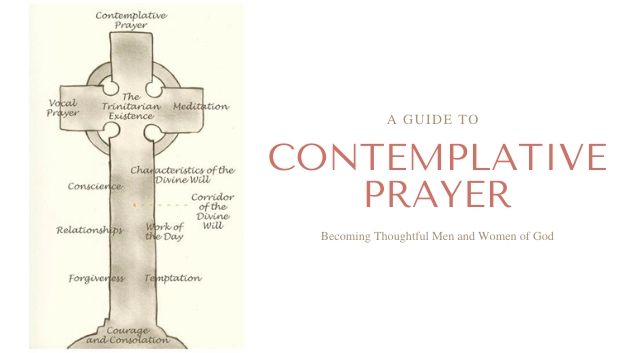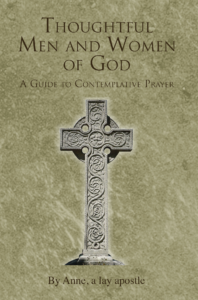
Jump To Links:
What is Contemplative Prayer and Why should we be practising it?
Visualisation – the Foundation of Contemplative Prayer
How to Pray Contemplatively- A Written Guide
How to Pray Contemplatively- A Video Guide
Download the Thoughtful Men and Women of God- A Guide to Contemplative Prayer Booklet, for free!
What is Contemplative Prayer and Why should we be practising it?
St. Teresa of Avila wrote of her vivid prayer experiences in her last book, Interior Castle. In this book she outlines the need for prayer and meditation in the Christian life, and speaks about the soul as an interior castle with many rooms. God is at the core of this castle, in the seventh “mansion” as she refers to it, and as we move through each mansion we become more intimate with him.
Interior Castle served as a manual through which St. Teresa instructed her religious sisters in how to engage in this type of prayer themselves. She, like our team, believes that the relationship which can be fostered with the Creator through this form of prayer is available to everyone who chooses to enter their “castle”. This deeply personal and reflective method of prayer draws us deeper into union with God and promotes a rich and intimate spiritual life.
Contemplative Prayer is good for our bodies, good for our brains, good for our souls. When we practise regularly it has a profound impact on our relationships with ourselves, others, and God, and we become more peaceful, thoughtful, and joyful.
Anne a lay apostle created a contemporary Contemplative Prayer structure for our times in order to make Contemplative Prayer accessible to everyone. Through Kathryn Clarke’s personal initiative, The Backpack Program, we have developed a practical method for entering and practising this Contemplative Prayer structure. Our humble goal is to enable people to tap into their inner experience, be in charge of their own minds, and cultivate their own authentic, loving, and very important relationships with God.
“My dear children, I wish you to spend time every day considering God’s will for you on this day. You must do this in silence. You may have many questions and it is in silence, in your heart, that we can answer these questions. Otherwise, you do not hear us over the noise of the world. Most of our children do not hear us, despite our attempts to communicate with them. Even many of our chosen ones neglect this form of contemplative prayer. Children, it is in this prayer that you will find the peace and guidance you require. I want others to see Christ in your face. For this to happen, you must be united with Christ. As always, I bless you and extend my hands over you in love.”
Blessed Mother – Volume One, Monday July 21, 2003
Visualisation – the Foundation of Contemplative Prayer
Visualisation is a very important part of Contemplative Prayer. Visualisation means forming mental images in your mind, usually with your eyes closed.
If this seems difficult at first, you can close your eyes and think of a place you know well – when doing this exercise in the Backpack, we instruct the participants to imagine themselves standing in their kitchen, then walking to their bedroom. Picture the details of the place you have chosen, what you can see to your left, your right, furniture, windows, take note of the lighting and the temperature, reach out and “touch” something (ie, the fridge, or a countertop). Use all of your sensations (see, hear, touch, smell, taste) as vividly as you can, to bring more reality to the image.
Our brains do not know the difference between actually doing something, and strongly visualising it. So when you visualise your kitchen or any other place you are familiar with in this highly vivid manner, your brain will physically change according to this mental image.
The same principle applies when you are in your prayer rooms in the Contemplative Prayer structure. Contemplative Prayer literally rewires our brains. For your Contemplative Prayer rooms, you are doing exactly the same thing as picturing your kitchen, except this time with rooms you may never have seen before, so there is a little more imaginative work here.
“In terms of recovering our minds from the more general over stimulation caused by too much entertainment and information, we began last month introducing our contemplation formula. The goal of this formula is to give us all a methodology for allowing Jesus to actively direct and heal us. We introduce this framework to offer a structure for allowing Jesus to heal, console, enlighten and then direct us… Our goal is to become saints in contemporary time. We need to develop for ourselves a picture of what WE would look like if WE were saints. And we need to begin a determined advance in that direction.”
Taken from Anne’s October 2013 First Thursday Talk. Click here to listen to that talk.
How to Pray Contemplatively- A Written Guide
- Close your eyes, relax your body, take three deep, slow breaths. Make sure you are breathing all the way from your stomach. Oxygen is very important to relax your body.
(It is important for your body to be in a deeply relaxed state. For a guided Progressive Muscle Relaxation track, see the Backpack website) - When your body is completely relaxed, picture yourself standing outside a door. Notice what the door looks like – what colour is it? What size? Is it wood, metal, something else? Notice every little detail about this door. It can be a door you have seen before, or entirely new. When you can see the door clearly in your mind, you can open the door and enter the room.
- You are now standing in your Contemplative Prayer room. Take a look around and notice what this room looks like. How big is it? Notice the ceilings, walls, floors, every detail. Use all of your senses.
- Make sure there is a space within this room for you and God to be together. This often takes the form of a seating space, such as a chair or a swing.
- Pray! Each room has a function, so if you are in your forgiveness room, you can look at images of people you would like to forgive, in your work of the day room you can contemplate your daily tasks and ask God for guidance, and so on.
- When you are finished with your prayer in this room, move to the next one. Repeat the process of designing and noticing each room and praying.
- When you have completed the whole structure or are finished with your prayer experience, sit down in the last room in your mind, close your eyes, and count from one to five. At the count of five you can open your eyes and come out of your prayer.


